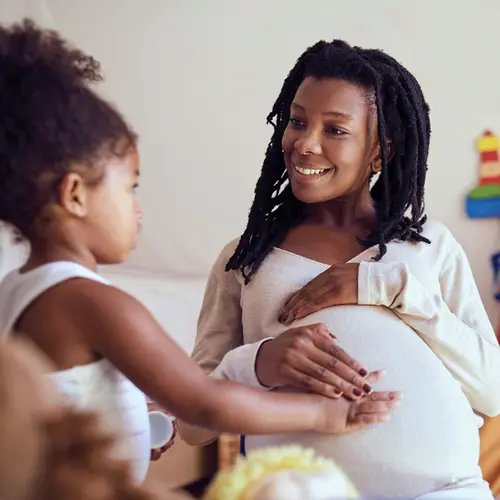Thicker, fuller hair is one of the best side effects of pregnancy. Many pregnant women say they have the best hair of their lives during pregnancy. Unfortunately, just like pregnancy itself, the great hair is temporary.
It can be an unpleasant surprise when your hair starts thinning a few weeks after your baby is born. You may find loose hairs on your pillow and clothing, or hair might clog your shower drain. This increase in hair loss is perfectly normal. It happens because of changing hormone levels after pregnancy.
Learn more about postpartum hair loss (hair loss after giving birth) and what you can do about it.
What Causes Postpartum Hair Loss?
When you're pregnant, your body changes in response to the new hormone levels needed for the baby to develop. The new balance of hormones, notably increased estrogen, changes your hair growth cycle. Hair remains in a growing phase longer during your pregnancy instead of shifting to a resting stage. Since the hair doesn't come to the end of its growth cycle as quickly, you don't lose as many individual hairs each day. The result is fuller hair.
Hair Growth Cycles. Hair goes through several phases of growth. The first phase is the growing phase, also called the anagen phase, where hair is actively getting longer. The second phase is called the catagen phase, or transitional phase, where hair growth slows and the hair follicle becomes smaller. The third phase is the telogen phase, or resting phase, where the hair doesn't grow anymore. After the resting stage, the individual strands of hair eventually fall out. A new hair then starts growing to replace the one that came out.
Hairs are usually in the anagen phase for two to four years. You can expect that 85% to 90% of your hair is in this phase at any given time. Once your hair goes into the telogen phase, you can expect it to stay at one length for two to four months. After that, the hair falls out. During your normal hair growth cycle, 100 or so hairs naturally fall out each day.
Hair Loss After Giving Birth. Once you have had your baby, your hormone levels return to their pre pregnancy levels. The drop in estrogen triggers your hair to go back to the cycle of growth, resting, and falling out. A significant portion of your hair will begin the resting phase right away. Several months later, the hairs have completed their resting phase and start to fall out.
Postpartum hair loss is noticeable because it's much more than the 100 hairs a person typically loses per day. The technical name for this type of hair loss is telogen effluvium, which means excessive shedding. The hormone fluctuations that happen in women who are postpartum cause more strands of hair than usual to enter the resting stage and then fall out a few weeks later. You may find that you are losing as many as 300 hairs per day.
Is Postpartum Hair Loss Permanent? The increased hair loss after having a baby is not a sign that you are losing your hair permanently. Your hair should return to its usual growth patterns over time. By the time your baby is one year old, you can probably expect your hair to be as full as it usually is at the roots. However, the new hairs growing in will be shorter than the other hairs on your head.
If your hair continues to get thinner or doesn't seem to be growing back, you can discuss it with your doctor. You may have another health issue causing hair loss, such as anemia or a thyroid condition.
What to Do About Postpartum Hair Loss?
You can't prevent postpartum hair loss. It's a normal part of the recovery from pregnancy. There aren't any treatments to stop telogen effluvium or to speed up new hair growth. Doctors recommend eating a healthy and balanced diet. This may help hair grow after the shedding phase ends.
The hair you shed after having a baby will grow back over time. However, you may notice that you have a lot of new hairs that are much shorter than the rest of your hair. These are the new strands growing in, and they are a normal part of the postpartum hair growth process.
You may not like the look of your hair during the shedding and regrowth phase. In that case, you can use styling products or techniques to improve the way your hair looks. Try lightweight conditioners to avoid weighing hair down and making it look limp. Volumizing products can make your hair appear fuller. A fresh cut or new color can also improve how your hair looks. Your stylist might be able to suggest styling tips that would help as well.


